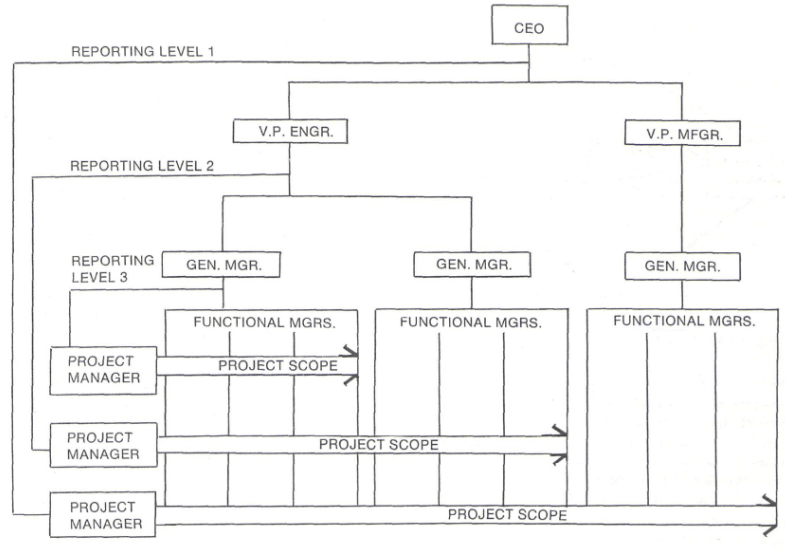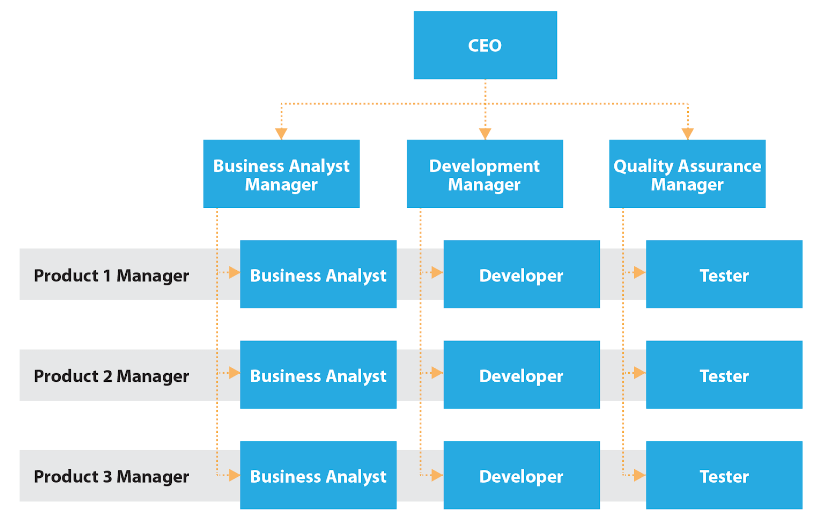
Click the button to start reading
Your Complete Guide to the Matrix Organizational Structure (With Examples)
The business world is constantly changing. Do you have what it takes to keep up? And how do you balance the priorities of different teams and projects?
Keeping your business processes efficient can be a tough call. But if you’re looking for ways to enhance project performance, the matrix organizational structure should be just what you need.
Matrix organizational structure allows managers to have more control over the project while still leveraging the skills and expertise of functional teams. By sharing resources across departments and functions, you can easily optimize resource utilization and improve decision-making and problem-solving.
As an innovative approach to organizing a company, the matrix organizational structure has gained popularity in recent years. But it’s not without its challenges. In this guide, we’ll explore what the matrix-based organizational structure is, its pros and cons, and how to implement it effectively.
Whether you’re a business owner considering a new organizational structure or an employee curious about how the matrix structure works, this guide will help you navigate the complex world of the matrix organization.

What is a matrix organizational structure?
In a matrix organizational structure, employees report to more than one manager. In this case, the traditional top-down hierarchy doesn’t work. Instead, as the name suggests, the reporting lines in the team are arranged in a matrix.
Think of a matrix organizational structure as a sports team that has both a head coach and assistant coaches. The head coach represents the functional manager, who oversees the team’s overall strategy, training, and development. Meanwhile, the assistant coaches represent project managers, who are responsible for leading individual projects or initiatives.
Each assistant coach works with a specific group of players to develop their skills. However, all coaches work together to ensure that the team is functioning as a cohesive unit and achieving its overall goals. Similarly, in a matrix organization, employees have both a functional manager and a project manager who work together to ensure that they’re developing the skills necessary to contribute to the organization’s success on both individual projects and overall goals.

Project management reporting levels (Image credit: PMI)
History and origin: a quick glance
The matrix organizational structure was first developed in the aerospace industry in the 1960s. Team leaders used this concept to address the complex challenges of managing large-scale projects, such as the development of military aircraft and space programs. The matrix structure helped to bring together specialists from different functional areas, such as engineering, manufacturing, and testing, to work collaboratively on a specific project.
Since its development in the 1960s, the matrix structure has become a widely used organizational design, particularly in large corporations that manage complex projects and initiatives.

How to make the matrix organizational structure work?
More and more teams steer away from the hierarchical organization to move more quickly and boost their flexibility. In fact, 73% of digitally maturing companies intentionally build a work environment where cross-functional teams can unlock their full potential.
We’ve handpicked tried-and-tested tips to help you make the matrix organizational structure work effectively.
Tip 1: Clearly define roles and responsibilities.
It’s crucial to define and communicate clear roles and responsibilities for each employee, including their reporting structure and the expectations for their work. This helps to avoid confusion or conflicts that can arise from having multiple managers.
Tip 2: Build a culture of collaboration.
A successful matrix structure depends on cross-functional collaboration and teamwork. Therefore, leaders should work to create a culture that encourages cooperation between departments and teams.
Tip 3: Provide training and development opportunities.
Employees in a matrix organization need to have the skills and knowledge to work across functional areas and adapt to changing priorities. That’s why offering training and development opportunities can help employees handle the demands of the matrix structure successfully.
Tip 4: Use technology to support communication.
Effective communication is the foundation of the matrix organization. Using collaboration tools and project management software, such as Teamly, can help you facilitate communication and coordination between employees and teams.
Tip 5: Establish clear decision-making processes.
Confusion? Conflicts around decision-making? You can’t avoid them in a matrix organizational structure. That’s why leaders should boost effective cross-team collaboration and establish clear processes for making decisions.

Who is the boss? Finding the balance of power in a matrix organization
Will your matrix organizational structure be a success? It greatly depends on the balance of power between two roles: the functional manager and the project manager.
If the balance of power is too heavily weighted towards the functional manager, it can lead to conflicts between the functional and project teams. The reason is – the project manager may not have enough authority to make critical project decisions. Conversely, if the balance of power is too heavily weighted towards the project manager, it can lead to conflicts with the functional manager over resource allocation and training.
To make the matrix organizational structure work effectively, both managers need to have a shared understanding of their roles and responsibilities, including decision-making authority, resource allocation, and performance evaluation. Integrating flowchart symbols into the documentation and planning phases can aid in delineating these roles and responsibilities more clearly, ensuring a harmonious operational flow within the matrix structure.
Types of matrix organizational structure
There are three main types of matrix organizational structure: weak, balanced, and strong.

Types of organizational structure (Image credit: ScienceDirect)
Depending on the type of matrix structure, the roles and authority of the functional manager and project manager vary.
Weak matrix
In a weak matrix structure, the functional manager holds more authority than the project manager. This implies that the project manager’s primary responsibility is to coordinate the project, while the functional manager has more control over the team members’ performance and development. This type of matrix structure can be beneficial for companies with limited resources and a low level of project complexity.
Balanced matrix
In a balanced matrix structure, the functional manager and project manager share equal authority. As such, both managers have joint responsibility for the project’s success, and employees may report to both managers. This type of matrix structure can be helpful in ensuring a fair balance between the functional and project manager’s roles.
Strong matrix
On the other hand, in a strong matrix structure, the project manager holds more authority than the functional manager. Consequently, the project manager has greater control over the project’s budget, resources, and staffing. The functional manager’s role is more advisory in nature. This type of matrix structure is most suitable for organizations with complex projects that demand a high level of project manager authority.
A quick example of a matrix organizational structure
As explained above, the matrix organizational structure is a hybrid structure that combines two types of organizational structures: functional and project-based.
Here’s an example of how a matrix organizational structure might work in a software development company.

A sample of a matrix organizational structure (Image credit: BCcampus)
As illustrated in the picture above, the CEO oversees three branches, each with its own manager: a business analyst manager responsible for supervising business analysts, a development manager responsible for overseeing developers, and a quality assurance manager responsible for supervising testers. Additionally, there are three product managers who each supervise a business analyst, a developer, and a tester for their respective products. This means that the business analysts, developers, and testers have to report to two different bosses in this setup.
To sum up, a matrix organizational structure allows a software development company to effectively manage software development projects. Teams are cross-functional, which makes them accountable to both their project team and their functional department. The reporting lines in this structure ensure that there is clear accountability and communication among all levels of the organization.

Advantages and disadvantages of the matrix organizational structure
Each type of matrix structure has its own advantages and disadvantages, and you need to carefully consider your specific needs when selecting a matrix structure. To help you make a decision, let’s now explore the pros and cons of the matrix organizational structure.
Advantages of matrix organizational structure
The matrix organizational structure is a dynamic approach to business management that offers numerous advantages over traditional structures. From increased adaptability to employee development opportunities, here are some of the key benefits that make it an attractive option for businesses:
Adaptability and resilience to change
In a matrix structure, resources are spread across different departments and functions, making it easier to pivot and adapt to changing circumstances. Therefore, you can optimize your resource utilization and remain competitive in an ever-changing business environment.
Enhanced communication
The matrix structure encourages communication and collaboration across departments, allowing for more efficient decision-making and problem-solving. This can lead to improved overall team performance and better outcomes.
Use of field-specific expertise
The matrix structure is particularly effective for managing complex projects that require specialized skills and expertise. It enables project managers to have more control over the project while still leveraging the skills and expertise of functional teams.
Employee development opportunities
In a matrix structure, employees have the opportunity to work on different projects, collaborate with colleagues from different functional areas, and develop new skills and expertise. This can provide valuable opportunities for growth and development, leading to increased job satisfaction and engagement.
Increased job satisfaction
The matrix structure can lead to increased employee satisfaction and engagement, as employees have more autonomy and opportunities for professional growth and development. Usually, this leads to a more positive and productive work environment, benefiting both employees and the organization as a whole.
Having said that, you should take note of the following: while the matrix organizational structure is a popular approach to business management, it isn’t without its drawbacks. In a moment, we’ll discuss the key cons that organizations should consider. But before we explore the disadvantages of matrix organizational structure, let’s see an example of a successful matrix structure.
An example of successful implementation of matrix organizational structure
Philips Electronics is one of the earliest and most well-known examples of a company that successfully implemented the matrix structure. As a result, the company achieved improved financial performance and increased competitiveness.
In the 1970s, Philips underwent a major restructuring, adopting a matrix structure in order to improve its competitiveness and streamline its operations.
Under the new structure, Philips was organized into four main product divisions, each with its own profit and loss responsibility and a number of shared service organizations that provided support to the product divisions. The matrix structure allowed for greater collaboration between different departments and facilitated faster decision-making.
Philips uses the matrix structure to bring together various functional teams to work on specific projects. For example, the company’s Consumer Health division uses a matrix structure to bring together teams responsible for different product categories, such as oral healthcare, mother and child care, and respiratory care. This allows Philips to leverage the expertise of different teams and functions to create innovative products and solutions.
Furthermore, Philips uses the matrix structure to manage its research and development efforts. The company’s Research division is organized around four key areas of focus: healthcare, lighting, consumer lifestyle, and emerging businesses. Researchers in each of these areas collaborate with functional teams from across the company to develop new products and technologies.
The success of Philips’ matrix structure was attributed to a number of factors, including strong leadership, effective communication, and a clear definition of roles and responsibilities. The company also invested heavily in training and development programs to help employees adapt to the new structure and collaborate effectively across different departments.
Disadvantages of matrix organizational structure
The matrix structure has its drawbacks you should be aware of:
Complexities in team management
The matrix structure is complex and can be challenging to manage, especially in large organizations. It requires clear communication, well-defined roles and responsibilities, and a culture of collaboration and teamwork. If these elements aren’t in place, the structure can become a burden rather than a benefit.
Conflicting priorities
In the matrix structure, employees may have to report to multiple managers with different priorities and interests. This can result in conflicting priorities, making it challenging for employees to prioritize their work and create a cohesive team. As a result, it can be challenging to align goals and objectives across the organization.
Ambiguity in roles and responsibilities
The entire team may face confusion and a lack of accountability. Employees may be unsure of what they need to accomplish. Rather quickly, the matrix structure may start hindering productivity and performance.
Slow decision-making
The matrix structure can sometimes lead to slow decision-making, as decisions may need approvals from multiple managers. This can create bottlenecks and delay project completion.
Increased cost
The matrix structure can be more expensive than other organizational structures as it requires additional resources for coordination and communication. This can put a strain on budgets and resources.
In summary, while the matrix organizational structure has several advantages, it also has some potential drawbacks that organizations need to consider before adopting it.
An example of a failure to implement a matrix organizational structure
One example of a company that shifted to a matrix organizational structure and experienced significant challenges is Cisco Systems. In the late 1990s, Cisco Systems adopted a matrix organizational structure in an effort to better align its product development with customer needs and to improve collaboration between its engineering and sales teams.
However, the implementation of the matrix structure proved to be more challenging than expected. The company struggled to define clear roles and responsibilities, leading to confusion and conflicts between employees. The dual reporting structure also led to slower decision-making, as decisions often had to be approved by multiple managers.
Furthermore, the matrix structure led to increased bureaucracy and overhead costs, as additional resources were required to coordinate and communicate between departments. This led to increased frustration among employees and contributed to a decline in morale.
As a result, in 2001, Cisco Systems abandoned the matrix structure and returned to a more traditional functional structure. While the matrix structure did provide some benefits, the challenges that the company experienced outweighed these benefits and ultimately led to its failure.

How to build your own matrix organizational structure
Building a matrix organizational structure involves several steps. Here are the major considerations to keep in mind:
Step 1: Chart your course
Define your objectives: What do you want to achieve with your matrix structure? Whether it’s increasing innovation or reducing duplication of effort, defining your objectives is the first step towards success.
Step 2: Choose your units
Identify the business units that will form the foundation of your matrix structure. Will you group them by product line, geography, or some other factor?
Step 3: Define who reports to whom
Determine the reporting lines for each business unit. In a matrix structure, employees typically report to both a functional manager and a business unit manager.
Step 4: Be clear about responsibilities
Make sure employees know their roles and responsibilities. In a matrix structure, employees may have multiple managers and need to work across different departments, so it’s essential to establish clear guidelines.
Step 5: Build a cooperative environment
Establish communication channels to ensure that employees can effectively collaborate across different departments. This could include regular team meetings, cross-functional projects, or other initiatives.
Step 6: Equip your team
Provide training and support to help employees adapt to the new structure and collaborate effectively. This could include training in project management, communication skills, or other relevant areas.
Step 7: Keep your hand on the pulse
Monitor the effectiveness of the matrix structure and make adjustments as needed. Be ready to modify reporting lines, revise roles and responsibilities, or make other changes to keep your structure working smoothly.
With these steps, you’ll be well on your way to building a successful matrix organizational structure that’ll improve collaboration, boost innovation, and drive your business forward!

What tools to use to build your own matrix organizational structure?
There are several tools and software that can help you build a matrix organizational structure.
Org chart software: Visual tools can help you create visual representations of your matrix structure. These tools often include templates and drag-and-drop features, making it easy to build and modify your structure.
Project management software, such as Teamly, can help you manage tasks and projects across different departments and teams. These tools often include features for assigning tasks, setting deadlines, and tracking progress. By the way, Teamly also includes communication features to help you facilitate collaboration with anyone, anywhere.
Analytics software: Analytics software can help you track key performance metrics, spot areas for improvement, and optimize your matrix structure over time.
Ultimately, the specific tools and software that you choose will depend on your organization’s needs and context. Remember to carefully evaluate your options and choose tools that are well-suited to your particular situation.
Key takeaways
The matrix organizational structure may not be the perfect fit for every organization. Why? Because the way a matrix structure works can make managers feel confused and pulled in different directions.
However, the matrix organizational structure is a powerful tool that can help you optimize your resources, enhance collaboration, and improve project outcomes. By determining reporting lines, defining responsibilities, and establishing communication channels, you can successfully implement a matrix structure and reap its many benefits.
What’s more, with the right software tools, everyone can easily work together and find solutions that help the whole organization reach its goals.
















